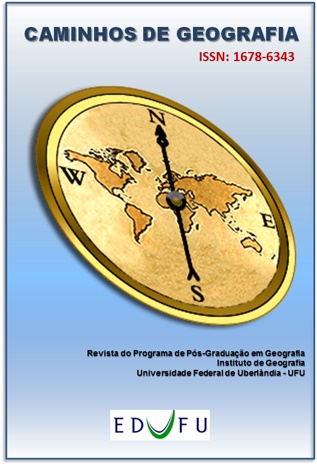O CONSUMO DE FLÚOR EM ÁGUAS SUPERFICIAIS E TERRITÓRIOS DE RISCO PARA A SAÚDE HUMANA NA REGIÃO NORDESTE DO PARANÁ
DOI:
https://doi.org/10.14393/RCG228155186Palavras-chave:
Flúor, Riscos, Hidrogeoquímica, Nordeste do Paraná, Saúde ColetivaResumo
No Nordeste do Paraná se assinalam teores de fluoretos em águas superficiais de abastecimento público, acima dos recomendáveis para a saúde humana (≥ 0,8 mg/L de F-). Tendo em vista que a ingestão de teores diários de flúor fora do intervalo de 0,6 a 0,8 mg/L de F-, seguindo o rigor da lei brasileira, possibilita a geração de patologias como a cárie e a fluorose, se objetiva nessa investigação apontar localidades onde as concentrações naturais de flúor obtidas em drenagens, delimitem áreas de risco para a saúde humana pela ingestão direta ou fluoretada. Para tanto, duzentas amostras de águas brutas georreferenciadas foram coletadas (2016-2018) em bacias hidrográficas que abastecem a região, sendo todas analisadas quimicamente para flúor através da técnica da Potenciometria Direta (teores até 1,2 mg/L). A espacialização dos dados, indica municípios potencialmente propensos ao risco de fluorose dental cujos picos de teores se alinham na direção SW-NE, como um cinturão de anomalias (Jundiai do Sul, Santo Antônio da Platina e Jacarezinho). Também indicam municípios com risco a cáries. Adicionalmente se constata, que novos levantamentos epidemiológicos e hidrogeoquímicos devam ser realizados, sobretudo em águas subterrâneas, para melhor delimitar a abrangência dos riscos e suportar o planejamento da Saúde Coletiva.
Downloads
Downloads
Publicado
Edição
Seção
Licença
Autores que publicam nesta revista concordam com os seguintes termos: a) Autores mantém os direitos autorais e concedem à revista o direito de primeira publicação, com o trabalho licenciado sob a Creative Commons Atribuição-NãoComercial-SemDerivações 4.0 Internacional. b) Autores têm permissão e são estimulados a publicar e distribuir seu trabalho online (ex.: em repositórios institucionais ou na sua página pessoal), já que isso pode gerar alterações produtivas, bem como aumentar o impacto e a citação do trabalho publicado. c) Em virtude de aparecerem nesta revista de acesso público, os artigos são de uso gratuito, com atribuições próprias, em aplicações educacionais e não-comerciais.











